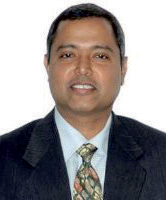
Paul Gaudio
Co-Founder
Adidas
Our mission is to eliminate plastic waste from the fashion industry
Former global creative director of Adidas and current Co-founder of UNLESS, Paul Gaudio is known for his creative product and sportswear design contributions. In an interview with Fibre2Fashion, Gaudio talks about the sportswear industry and its contribution towards sustainable creations.
Fibre2Fashion: Can you walk us through your teenage days and internship period?
Paul Gaudio:
I grew up in Pittsburgh, PA, US, and along with playing sports, I was fascinated with all things mechanical and creative. From building things, to art, fashion, music,etc and the way those things were all interconnected. I was always trying to design and make things from graphic tees and customised sneakers to skateboards and even prom dresses. That led me to design school at Carnegie Mellon University where I studied industrial design. My first internship was far from glamorous, working as a student for a local design firm mostly doing grunt work around the studio. I didn’t really start my career until I graduated and joined another industrial design firm in Pittsburgh, where I worked on medical products, transportation design and even scientific equipment. It was hard work, had a lot to learn and a lot of responsibility thrown on me at a young age, but it somehow felt like I was getting paid to do what I’ve done for fun, so I loved it.
F2F: What sparked your interest in creative design, and how would you elaborate your journey?
PG:
My grandfather had a small business refinishing and reupholstering furniture. I spent a lot of time in that shop, as a little kid, playing around with the tools, materials, fabrics and colours. I don’t know if that’s where my interest started as much as how my interests were nurtured and developed. I was always drawing and building in my spare time. I guess I always loved the idea that you could make up your own ideas, create your own realities, build what you couldn’t buy…or even just pretend to do that. It wasn’t something that I was intentional about, it just came naturally, the same way your taste in food or music does. It just felt good, so I did it.
F2F: How did the idea for wearable tech and responsive products emerge to you?
PG:
I think we were just excited by the possibilities of marrying the physical and virtual worlds. The wearable tech (or IoT) space was just starting to develop, and we saw the opportunity to use that technology to help athletes progress in their journey to get better. Technology should serve humanity, and we imagined a world where on-body sensors and wireless communications could provide real-time feedback and coaching to athletes, trainers or even regular people who don’t have access to coaches or training facilities. As a designer, the challenge of integrating technology into your sporting, or even daily life has always fascinated me, so personally this was also a very interesting territory to work in. It’s not mandatory, but it’s great when you get to work on things that you have a curiosity about or a clear vision for.
F2F: Do you believe in the concept of sustainable creation? How viable is sustainability in the sportswear industry?
PG:
F2F: How can collaborations with brands and celebs affect a brand in terms of design and sales?
PG:
Collaborations are a well-worn way to create excitement and to add dimension to a brand. It is important that each party in a collaboration bring something unique and complementary to the party. The best collabs lead to new ideas that either party would not, or could not, have done themselves. Collabs with celebs, especially those with their own creative point of view, or with their own sense of purpose are especially powerful – and of course, work best when their values and views on the world are aligned with yours.
F2F: What are your thoughts on designs being copied?
PG:
F2F: Are there still boundaries between sports clothing as everyday clothing, and high fashion?
PG:
Less and less, but honestly people have been wearing sports gear for casual use as long as I’ve been alive. Over the last few years, sportswear has completely bled out into all parts of fashion. Partly because of the comfort, but also because of the innovation, and energy that the sports world can generate in society. But like everything, these trends evolve, ebb and flow from year to year and you are already starting to see the influence of sportswear on the runways dissipate. This will eventually trickle down to everyday fashion, but for sure we’ve been living through sportswear’s biggest moment.
F2F: According to you, what are the three things that sportswear brands need to work on?
PG:
1) Diversity and inclusion in the boardroom, in the C-suite, in management positions and across the employee base, 2) Taking environmental (cradle-to-grave or cradle-to-cradle) responsibility for the products they manufacture and distribute and 3) Driving and scaling sustainable and ethical material and manufacturing process innovation, including near-shore and on-shore production.
F2F: Tell us about your few favourite projects that you did?
PG:
F2F: What are you working on currently and what are your forthcoming plans professionally?
PG:
Pradip Mehta
Fanny Vermandel
Bill D’Arienzo
Rahul Mehta
Anurag Batra
Gabi Seligsohn
Abhay Gupta
Rahul Mehta
Arun Sirdeshmukh
Aseem Prakash






_8.JPG)






